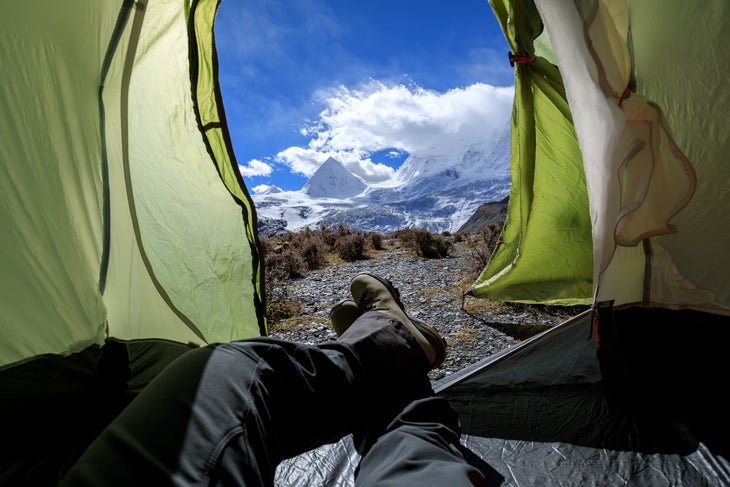Heading out the door? Read this article on the new Outside+ app available now on iOS devices for members! Download the app.
There’s an old adage among mountaineers: “Climb high, sleep low.” It takes time to adapt to a lower-oxygen environment; in theory, this strategy aims to periodically expose the body to higher altitudes, which avoids putting too much stress on climbers all at once. But in practice, acclimatization isn’t so straightforward. The process varies widely depending on factors like general fitness level, the particular mountain, and home elevation. When tackling a high-elevation peak like Mt. Kilimanjaro (19,341 feet), most guides recommend at least a week of acclimatization in the region prior to attempting a climb. But what should hikers preparing for a 14er do?
The difference in elevation that climbers experience on the Rockies’ highest peaks is less extreme than that of Africa’s highest summit, though not necessarily less dangerous. Altitude sickness is just one of a variety of potential hazards they face; fortunately, most evidence suggests that even a single night spent at high elevation can reduce health risks that come with high-altitude climbs—and the more time you can spend at elevation before the trek, the better. Here’s what we know about pre-acclimatization and sleeping at elevation to prepare yourself for a big climb.
Baseline Altitude
Climbing high-elevation peaks reduces blood oxygen levels, which is why many people develop altitude sickness. In the immediate acclimatization process, you breathe more often and your body forces blood into the pulmonary arteries in the lungs. There are variations, however, in the long-term adaptation process and timeframe. Determining if or how long to acclimate depends on an individual’s starting elevation.
“I think it’s in part a question about who we’re talking about,” says Matt Formato, a lifelong athlete and founder of Mile High Training, an organization that specializes in home altitude training systems. “If it’s a person that lives in Colorado, they’re likely acclimatized to some degree even at moderate altitudes in Boulder or Denver. They’re tremendously more acclimatized going into that 14,000-foot peak than someone who is coming from Houston.”
According to the CDC, from sea level, it takes about 3 weeks to fully acclimate to 6,000 feet of altitude, 4 weeks to acclimate to 8,000 feet, 5 weeks to acclimate to 10,000 feet, and 7 weeks to acclimate to 14,000 feet. So, those who live at a higher elevation have an advantage when preparing to climb a peak.

Sleeping at Elevation Before a Climb
One of the challenges that new climbers face is unfamiliarity with common symptoms of altitude sickness, such as headaches, dizzy spells, and feeling nauseated and weak. But even in the absence of these symptoms, high elevations place a lot of strain on the heart and lungs. This is how many athletes manage to push themselves beyond their limits without even realizing it.
Research has shown that even a single night of sleeping at altitude significantly reduces the risk of heart attacks while in the high country. Dr. Robert Shapiro, a cardiologist for Boulder Community Health, notes that even a single day spent at elevation before a climb can reduce the likelihood of sudden cardiac death by six times. Furthermore, a randomized study published in the journal of the Wilderness Medical Society suggested that sleeping in a mildly hypoxic state at home (in an altitude chamber or with a mask on) can help to reduce altitude sickness symptoms as well, meaning that hikers do not necessarily need to travel to prepare for the strain of elevation.
Anecdotal evidence from hikers suggests that spending time at the trailhead or at a campsite below a peak can make a difference, and many medical professionals agree. Aspen Hospital, which is located at an elevation of 8,000 feet, recommends a slow acclimatization process for best climbing results. The hospital suggests that visitors from out of state plan on sleeping in Denver for a night before ascending to Aspen. The general rule of thumb is “not to sleep higher than 1,600 more feet per day,” a number that the Center for Disease Control and Prevention emphasizes as well.
Timing the Ascent
In addition to evaluating how to train or where to sleep prior to a mountain ascent, timing the ascent in relation to acclimatization can be complicated. Formato said that it “depends on how much time you have and how high you’re going.”
Beginners should err on the side of caution and attempt to give themselves extra time at altitude before scaling a peak.
“Certainly, for anyone [who is inexperienced and] going to do a 14,000-foot peak [in Colorado], go slowly. Go to Denver for a night. Breckenridge for two nights, then make your push,” says Formato.
“Your body starts producing red cells immediately, but it’s not going to be a mature cell for weeks,” he says. “If you’re trying to pre-acclimatize, you want to give yourself a couple days ahead of time … It can take about 18 to 23 days for the body’s red blood cells to catch up with the low oxygen levels.”
The key for hikers looking to scale high-altitude peaks this summer? Provide your body with just enough encouragement to begin to adapt to the high elevations. In situations where it’s difficult to acclimatize before a climb, Formato said that you can reduce oxygen saturation levels manually at home through altitude simulation tents, chambers, or hypoxicator masks. Purchasing these products can be pricey, but there are plenty of workarounds. Don’t want to buy an altitude tent? You can rent one in the weeks leading up to your trip. Also, for Denver locals, you can test what it’s like to work out in low-oxygen settings: Traverse Fitness is a gym with an altitude studio formally only for elite athletes. Now, anyone can book a free class and work out in a studio simulating anywhere from sea level to 18,000 feet.
From 2024